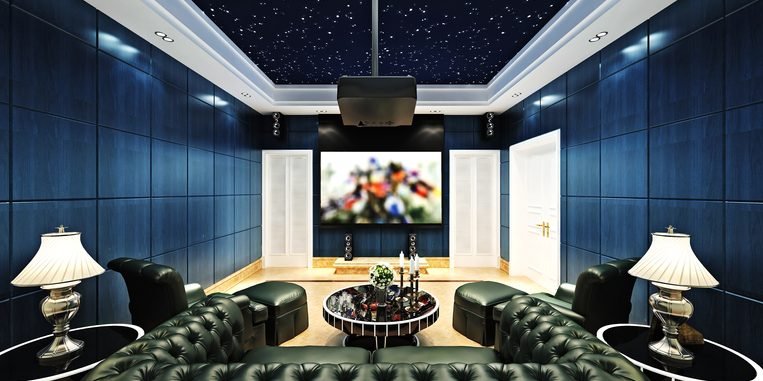
The term media room has evolved into a generic definition for a multipurpose space that is outfitted with a large flat-screen television, surround sound and cozy seating. Friends congregate there to watch the big game. Families go there to watch a movie together. It’s party central when guests visit.
In comparing a media room to a dedicated home theater designed to replicate a cinema experience, the flexibility of a media room is more practical for people who want to do more than sit in the dark and watch movies.
A media room is a more social experience. You may want to watch the big game, chat, and play with the kids. What do you do in a theater when someone’s talking? You go, ‘Shhh … we’re watching the movie.’ The lights are down, no talking, no reading. No answering cell phones.
For purists who want a night-at-the-movies ambiance, a home theater is the answer.
Making a Media Room
Flexible seating: Because a media room is for more than just watching movies, furniture pieces are arranged into conversation spaces that can be “broken down” when moveable chairs are shifted to face the screen. Rather than rows of face-forward seating, media rooms boast comfy sofas, room recliners and inviting loveseats.
Ample screen size: The screen should be large enough so everyone in the room can back up and view it from a good angle. Not sure what size to buy? First, know your screen size (measured on the diagonal). You should be able to sit back from the television a distance of two to three times that measurement for optimum viewing.
Sound-absorbent aesthetics: Fluffy sofas, drapery and carpeting help quiet reflections from the sound system.
Cutting-edge content: The ability to stream movies, music and more from “the cloud” has changed the way media rooms are configured. It’s not just a T.V. and DVD player anymore.
Do you plan to entertain while watching or listening to media?
Will you use the media system for purposes other than watching movies (such as gaming or streaming music for a party)?
Is flexibility important to you?
If you answered yes to these questions, a media room is the best fit.
Designing a Home Theater
Cinema lighting: Subtle lighting will preserve the picture quality. While new projection screens perform in higher ambient light conditions, the idea is still to prevent light from falling directly on the screen. Remote control dimmers on lights are ideal.
Sound is more than half the experience. But many people cut their budget short and focus mostly on the screen. We suggest taking your budget and dividing it into three equal parts for the screen, sound and room.
Setting the mood: Equally important to the cinema experience is comfortable seating and an acoustic environment that absorbs sound. Seating is generally arranged in rows, facing forward to replicate a movie theater. This way, everyone fully experiences the impact of the sound and picture.
Do you want to mimic the cinema experience at home?
Does your home contain a space that can be dedicated solely to movie-watching?
Do you already have a space in your home where family gathers socially to watch television or play games?
If you answered yes to these questions, you should talk to a professional about home theater installation.







Hi, this is a comment.
To get started with moderating, editing, and deleting comments, please visit the Comments screen in the dashboard.
Commenter avatars come from Gravatar.